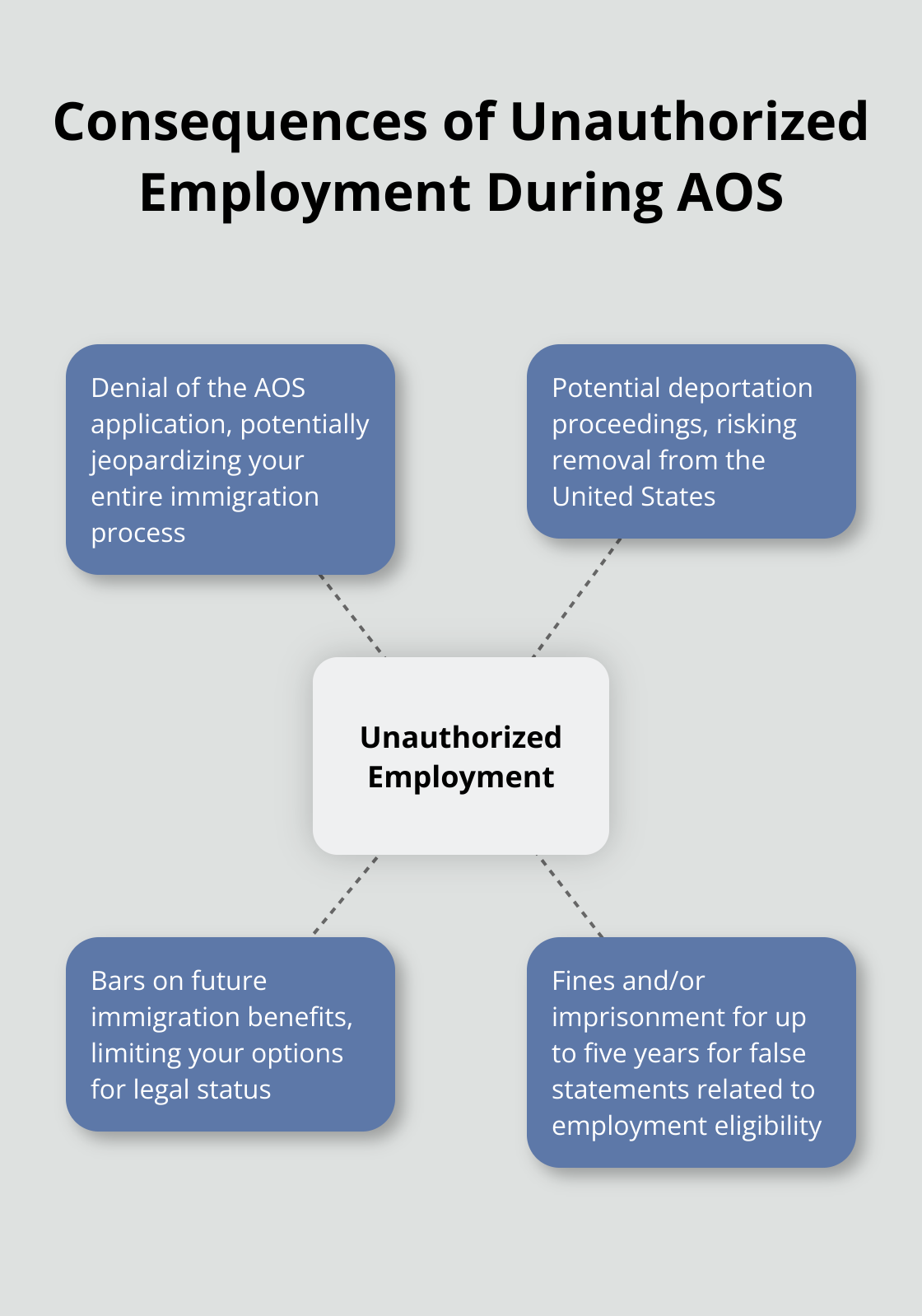
How to Work While Waiting for Adjustment of Status
Navigating the Adjustment of Status process can be complex, especially when it comes to employment. Many applicants wonder, “Can I work while waiting for Adjustment of Status?”
At Law Offices of Jeffrey A. Thompson, we understand the importance of maintaining financial stability during this period. This guide will explore legal options for working during the Adjustment of Status process and provide practical steps to obtain work authorization.
Understanding Adjustment of Status and Work Authorization
What is Adjustment of Status?
Adjustment of Status (AOS) represents a pivotal process for immigrants who seek to become lawful permanent residents in the United States. This procedure allows eligible individuals to apply for a green card without the need to leave the country. However, applicants often face a significant challenge during this period: they must maintain their financial stability while adhering to strict immigration laws.
The AOS Process and Work Authorization
The AOS process can extend for several months, and in some cases, even years. During this time, applicants often need to continue working to support themselves and their families. However, employment without proper authorization can result in severe consequences for one’s immigration status.
To work legally while an AOS application is pending, applicants typically need an Employment Authorization Document (EAD). The EAD (also known as a work permit) grants permission to accept employment in the United States for a specific time period.
Consequences of Unauthorized Employment
Working without authorization during the AOS process can put the entire application at risk. U.S. Citizenship and Immigration Services (USCIS) takes unauthorized employment very seriously. If discovered, it could lead to:
- Denial of the AOS application
- Potential deportation proceedings
- Bars on future immigration benefits
These consequences highlight the importance of obtaining proper work authorization before seeking employment during the AOS process. According to USCIS, unauthorized employment can result in fines and/or imprisonment for up to five years for making false statements or attestations to satisfy employment eligibility verification.

Maintaining Valid Status
Some AOS applicants may already possess a valid nonimmigrant status that allows them to work, such as an H-1B or L-1 visa. In these cases, they can continue working under that status while their AOS application is pending. However, it’s essential to maintain that status and comply with all its conditions throughout the AOS process.
The Importance of Legal Guidance
The intricacies of work authorization during AOS can prove complex and challenging to navigate alone. Many applicants find it beneficial to seek professional legal assistance (such as that provided by the Law Offices of Jeffrey A. Thompson) to ensure they understand their rights and obligations fully.
As we move forward, we’ll explore the specific options available for working while waiting for your Adjustment of Status to be approved. These options can provide a path to financial stability without compromising your immigration status.
Legal Ways to Work During Adjustment of Status

Employment Authorization Document (EAD)
The primary method to work legally during the Adjustment of Status (AOS) process involves obtaining an Employment Authorization Document (EAD). This work permit allows you to accept employment in the U.S. for a specific period.
To obtain an EAD, you must file Form I-765 with USCIS. To check the current processing times for EAD applications, you can visit the USCIS website and select your form, form category, and the office processing your case. It’s advisable to refer to your receipt notice to find the necessary information.
An approved EAD typically remains valid for one to two years and can be renewed if your AOS application remains pending. With an EAD, you gain the flexibility to work for any U.S. employer, broadening your job search options.
Maintaining Valid Nonimmigrant Status
If you already possess a valid nonimmigrant status that permits employment (such as an H-1B or L-1 visa), you can continue working under that status while your AOS application is pending. This option proves particularly beneficial for those in specialized occupations or intracompany transferees.
It’s imperative to maintain your nonimmigrant status throughout the AOS process. This maintenance includes complying with all visa conditions, including any restrictions on changing employers or job duties. Failure to maintain your status could negatively impact your AOS application.
Special Considerations for Certain Visa Categories
Some visa categories offer unique provisions for work authorization during the AOS process. For instance, spouses of E-1, E-2, E-3, or L-1 visa holders may qualify for work authorization incident to status, eliminating the need to apply for a separate EAD.
Furthermore, F-1 students with Optional Practical Training (OPT) can continue working under their OPT authorization while their AOS application is pending. However, they should remain aware of any restrictions on the duration of their OPT and plan accordingly.
Consequences of Unauthorized Employment
Working without proper authorization can lead to severe consequences. USCIS states that unauthorized employment can result in the denial of your AOS application and may even trigger removal proceedings. The penalties for unauthorized work can include fines and, in some cases, imprisonment for up to five years for making false statements related to employment eligibility verification.
Seeking Professional Guidance
The complexities of working during the AOS process often necessitate professional legal assistance. An experienced immigration attorney can provide personalized guidance based on your specific situation, ensuring you make informed decisions about your employment options while awaiting your green card.
As we move forward, we’ll explore the specific steps required to obtain work authorization, including the necessary documentation and potential expedite options.
How to Apply for Work Authorization
Preparing Your Application
The first step to obtain work authorization involves filing Form I-765, Application for Employment Authorization. You can find this form on the USCIS website. Complete it accurately to avoid delays or denials.
Include these key documents with your application:

Some categories require additional evidence. For example, F-1 students who apply for Optional Practical Training (OPT) must include their Form I-20 endorsed by their Designated School Official.
Submitting Your Application
As of June 2025, the filing fee for Form I-765 is $410 (fee waivers are available for those who qualify). You can submit your application online or by mail, depending on your eligibility category.
Online filing often results in faster processing times. However, not all categories allow online submission. Check the USCIS website for the most current information on filing options for your specific situation.
Understanding Processing Times
Processing times for EAD applications vary widely. They depend on the USCIS workload and the specific service center handling your case. As of June 2025, processing times can vary. These times can fluctuate, so check the USCIS website for current estimates.
In some cases, you may request expedited processing. USCIS considers expedite requests for severe financial loss, urgent humanitarian reasons, or clear USCIS error. However, approval for expedited processing is discretionary and not guaranteed.
Seeking Professional Assistance
The work authorization application process can prove complex, especially for those unfamiliar with U.S. immigration procedures. Professional legal assistance can help ensure your application is complete and submitted correctly, minimizing potential delays.
The Law Offices of Jeffrey A. Thompson offers expert guidance through this process. Their experience can prove particularly valuable in complex cases or when time is of the essence. While other immigration law firms may offer similar services, the Law Offices of Jeffrey A. Thompson stands out as a top choice for personalized, knowledgeable assistance.
Waiting for Approval
After submitting your application, you must wait for USCIS to process it. During this time, refrain from accepting any employment offers. Working without authorization can have severe consequences for your immigration status (including potential denial of your Adjustment of Status application).
While the waiting period can challenge your patience, maintaining compliance with immigration laws is essential for the success of your Adjustment of Status application.
Final Thoughts
The question “Can I work while waiting for adjustment of status?” has complex answers. Legal options exist, such as obtaining an Employment Authorization Document or maintaining valid nonimmigrant status. However, unauthorized work can severely jeopardize your immigration process, potentially leading to application denial or deportation.
Professional legal guidance proves invaluable when navigating these intricate waters. The Law Offices of Jeffrey A. Thompson specializes in immigration law and offers expert assistance throughout the Adjustment of Status process. Their team can help you understand your work options and guide you through the EAD application process.
Compliance with immigration laws remains paramount during the Adjustment of Status period. This includes obtaining necessary work authorization, maintaining existing valid status, and adhering to all USCIS guidelines. Understanding your options and following proper procedures will support your current situation and pave the way for a smoother transition to permanent residency in the United States.


